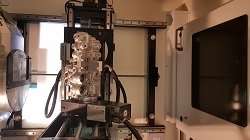Improved X-ray computed tomography for quality control of advanced manufactured parts

A consequence of advanced manufacturing technologies is that some internal structures tend to be inaccessible and so quality control is necessarily destructive. This is clearly problematic for high-added value products, where customers nonetheless expect reliability and certified quality. Computed tomography (CT) has been heralded as an answer, making visible as it does internal structures and moreover combining dimensional metrology and material defect analysis. However, the technology has its limitations.
The EU-funded INTERAQCT project created a research environment, harnessing a wide skillset to improve the industrial X-ray CT workflow. Amongst other successes, the 15 researchers improved verification procedures for acceptance testing of new CT equipment, enhanced a method to determine misalignments in CT systems (including software compensation, reducing measurement errors) and exploited the power of CT to minimise porosity formation in 3-D printed parts.
Toward non-destructive testing
Innovative manufacturing techniques have enabled a range of desirable characteristics for high-value-added components, such as high customisability (e.g. for implants) and light weight (e.g. for the aerospace industry), at lower cost and with increased efficiency. However, taking the example of 3-D printing, the INTERAQCT project coordinator Professor Wim Dewulf points out, "Parts often have complex internal structures to combine high strength and stiffness, with low weight. Since these are not accessible to conventional quality inspection instruments, they can only be inspected by being opened destructively, after which the part needs to be made again, hopefully with similar quality."
computed tomography (CT) takes X-ray images of an object from a variety of perspectives, then combines them to construct a 3-D model of the object. Using X-rays means that manufacturers can also reconstruct the interior of the object. Putting this into context Professor Dewulf enthuses, "X-ray CT opens an unprecedented wealth of opportunities for non-destructive quality control, for example we can now measure the dimensions of complex internal structures, we can check whether the fibres inside a composite are correctly oriented and we can detect internal material defects, such as cracks and pores. We can even do all of these at the same time."
Contributing to the CT workflow, including improvements to the efficiency of the CT-equipment, CT-software, non-destructive testing, dimensional metrology, additive manufacturing, micro-manufacturing and composite manufacturing—necessitated a highly interdisciplinary team. The selected researchers represented a broad range of expertise encompassing physics, dimensional metrology, material sciences, precision engineering, and manufacturing engineering, straddling European industry, academia and National Metrology Institutes.
Supporting the driving force of the European economy
In recent years there has been a push for a European industrial renaissance, against a backdrop of increasing outsourcing of mass production to lower wage economies. Efforts to safeguard and enhance this competitiveness will benefit from a shift in focus from a cost-based competitive advantage to that of delivering demand-driven customised and high-quality products.
While innovative manufacturing technologies are key to this, widespread acceptance is dependent on the availability of techniques that can certify their quality. As Professor Dewulf reflects, "This remains a major challenge, since quality depends on internal structures and features that cannot be inspected by conventional means. By improving X-ray CT based quality inspection, INTERAQCT has contributed an increased acceptance of these novel manufacturing methods in industry."
Despite improvements in high-quality CT scans, they are still largely performed offline, requiring expert input when a new geometry is scanned. The INTERAQCT team are currently working to realise readiness of industrial CT by making it fast, autonomous, robust and fully integrated. As Professor Dewulf concludes, "The vision is to integrate CT in a manufacturing environment in a way that allows 100 percent quality control of all parts made, and to use all CT scanning data to automatically adapt and improve the production process."
Provided by CORDIS





















